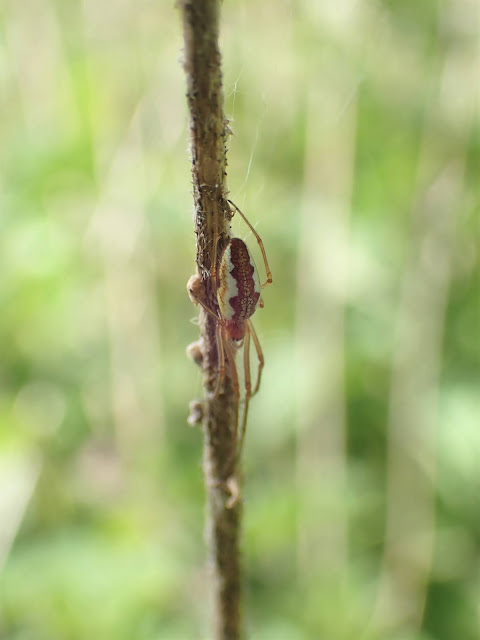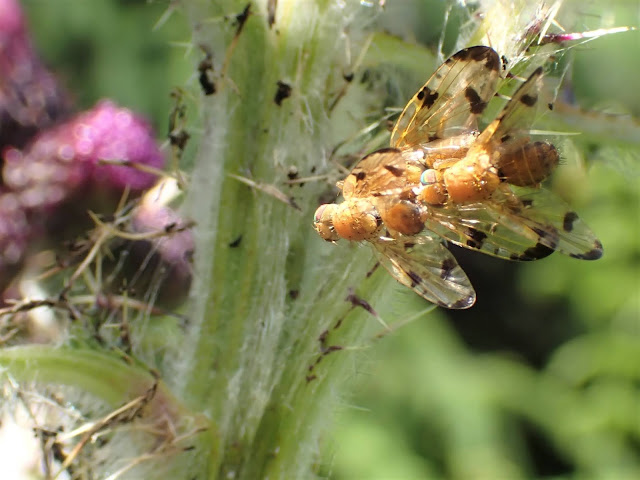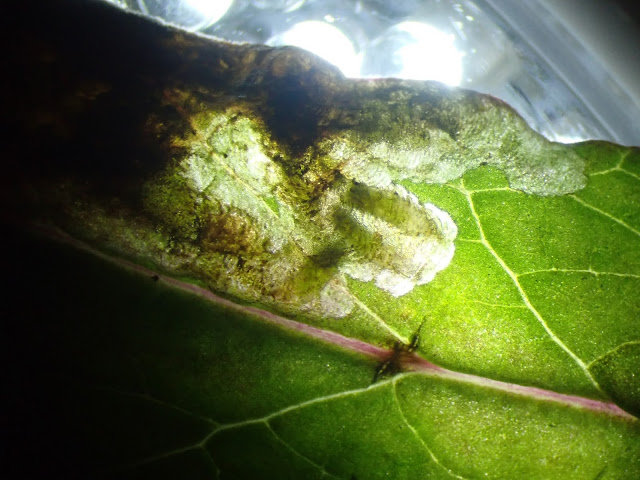Hope you guys are sitting comfortably......
The last time I posted here, springtime was just about to happen. And now it's the middle of July, so I guess it's fair to say that I've been a bit slack of late. If you follow my other blog (and I sincerely hope you do) you'll see that I have actually been active, despite the lack of posts here. The trouble is, I've been spending quite a bit of time messing about with plants rather than with spiders and flies. In truth I'm finding the spiders quite hard work, as a result I haven't spent very much time with them lately. I did scoop this rather lovely looking Pirata piraticus from the surface of a pool at the bottom of Coire a' Tairneilear a month or so back.
 |
| Adult female Pirata piraticus - a lifer for me |
A week later I swept a couple of adult female
Microlinyphia pusilla from a grassy patch of heathland, these were lifers for me too. Nationally it's a very widespread spider but, according to its
SRS species account, there are just a handful of Skye records, all from the southern half of the island. Mine were near Portree, which very definitely qualifies as being in the northern half of Skye.
 |
| Adult male Metellina mengei - different backgrounds to show the long hairs on metatarsus 1 |
I've recently started to see Araneus diadematus again for the frst time this year, always on coastal rockfaces which is pretty much the only place I ever find them up here. The vernacular name is Garden Spider. I've never seen one in a garden on Skye! I'm seriously thinking about lobbying to get the name changed to Coastal Rock Spider...
 |
| Araneus diadematus - quite a small one scrunched into a crack in the rock |
 |
| A fairy well grown male Araneus diadematus scurrying across a coastal rockface |
Other than finding Pholcus phalangioides in areas of the hotel I've never seen them before - housekeeping must be getting slovenly (sheesh, I hope they never hear me say that!!!), it's gone pretty quiet for all things arachnological, though I am still finding plenty of Mitopus morio on the hills, including this one exhibiting the pinkest dorsal stripe I've ever seen

I think my enthusiasm for entomology hit an all-time low a few weeks back. No real reason behind it, just stuff and whatnot, but I've definitely been through a bit of a 'phasing' event. To combat this, I've decided to change tack regards collecting specimens. Firstly I have decided to ease back with the spiders. There are lots of them and coming to a correct identification is usually quite an effort. Well it is for me, at least. If it isn't fun (and if you're not being paid for it), don't do it - it's that simple. So I'm easing back. That's not to say I'm stopping (hell no!) I still intend to learn much more about spiders as the year progresses, but I'm not prepared to wear myself into the ground trying to hit 100 species in a year, or whatever it was I was initially hoping to identify. That should be good news for The Ghost who, I believe, is struggling to find very much in the way of hopper activity down south. Our 'friendly' Challenge will doubtless remain in place until 11:59:59 on Dec 31st this year. He can be a stubborn git somewhat relentless like that.
I did something last week which pleased me no end, I accidentally knocked a Nuctenea umbratica from its hidey hole under the rim of a wheelie bin (no, that's not what pleased me, just read on...) As I said sometime earlier this year, these spiders have always made me very wary - they just look so evil! So I made a promise to myself that I'd handle the very next one I found, which is exactly what I did. Admittedly it wasn't fully grown, but it wasn't exactly small either. I let it run across my hands for a few seconds before it jettisoned to the ground on a silken line. And it didn't bother me at all! I make that Seth 1 : Arachnophobia 0. Get in, Gibster! Combating my mild arachnophobia was part of the reason I chose to look at spiders this year, it seems to be working too. I even found myself picking up a Tetragnatha montana a few weeks back, have you seen the size of the jaws on those things? They could probably peel the roof off a car! Anyway, it ran, well loped really, across my hand as I lifted it from my sweep net to return it unharmed to the grasses.
 |
| Tetragnatha sp. - probably montana, but immature so I didn't collect it |
And what about the flies, I hear you ask.
Well, there are several dipteran families that I'm already fairly familiar with (unlike the spiders), so I've taken a slightly different approach with them. Basically I'm largely ignoring anything that doesn't grab my attention or anything I don't think I'll enjoy keying through. So that gets rid of those leggy bastard craneflies for starters! Ha, I jest. Some are alright, but I think I need to be in the right frame of mind to bother swiping at small limoniids, for instance. If I see a Nephrotoma I'm having it, but by and large it's a case of live and let live with craneflies and gnats. I may give them some decent attention later, I'll just have to see how it pans out. Muscids. Man, they've certainly fallen from grace for me. I think it's precisely because they are so damned ubiquitous that I've amassed a considerable backlog (again!) of muscids and anthomyiids. So I'm steering clear of those too. Calliphorids, scathophagids, clegs, soldierflies, hoverflies and a few other families are where it's at for me. I enjoy those, so they definitely stay. I've quite a collection of empids and doli flies on pins, and they're ok most of the time, but I need to be in the right frame of mind before sitting down at the microscope with them. Reading that list back to myself, it seems I've plumped for the 'big and easy' flies. Hmmm, maybe? Not sure if that's true or not, but what's important is that they are families that I can find most days of the week (well, not soldierflies. They're a bit thin on the ground around here) and I enjoy keying them.
Here are a few of the flies I've seen since my last post some three months ago (insert facepalm emoji). First up, a few from May
 |
| Gymnocheta viridis (Tachinidae) - always a pleasure to see one of these |
 |
| Bibio marci (Bibionidae) - pretending to be a limpet. Unbelievably, this really is the first one I've ever seen on Skye! |
 |
| Cynomya mortuorum (Calliphoridae) - led me a merry chase before letting me grab this piccie! |
 |
| Male Bibio leucopterus (Bibionidae) - milky wing membrane and equal-sized spurs on fore tibia |
 |
| Female Eristalis intricaria (Syrphidae) - image taken looking into the light, so it's a shit shot of a lovely bee mimic |
 |
| Molophilus ater (Limoniidae) - flightless craneflies that were swarming on grasses |
I was decidedly less active on the diptera front in June, but I did still drum up enough enthusiasm to drag mysef away from the plants long enough to find a few bits and pieces
 |
| Eristalinus aeneus (Syrphidae) - as found by a visiting Ali! |
 |
| Phyllodromia melanocephala (Empididae) - a truly bizarre 2.4mm long raptorial fly |
 |
| Male Xylota segnis (Syrphidae) - more usually seen on leaf surfaces than in a flowerhead |
 |
| Rhagio scolopaceus (Rhagionidae) - it just wouldn't be summer without these guys! |
 |
| Lots of these on Goldenrod. Looks frighteningly similar to Calycomyza solidaginis which would be entirely new to Britain.....shoulda grabbed some to rear through! |
 |
| Aberrant Xyphosia miliaria (Tephritidae) with three bodies, two heads and six wings... |
 |
| Pegomya steini (Anthomyiidae) - three larvae inside an Alpine Saw-wort mine |
A bit of a mixed bag so far. I should have been swiping flies left, right and centre at this time of year, but the thought of facing another backlog box full of unnamed specimens was just too demoralising to contemplate. I've only really started getting back into flies again this past week or so.
The arrival of clegs is always something to look forward to...ha! I'd managed to find just one single solitary cleg up until the end of June (sweet!), but this last couple of weeks they've suddenly become annoyingly commonplace (I swatted SIX whilst up a ladder painting a wall). Remember, amongst other things, I'm also the gardener here at the hotel. There are nine lawns to mow, plus I have another three to do just down the road a bit. Then there are numerous strips of grass which get strimmed rather than mown. All in all, I'm a slow moving target for a good few hours of each week, and a complete sitting duck for any clegs intent on a blood meal. Mercifully I don't react to their bites, in fact I barely notice them at all - just a sudden itchy jab as they bite (and immediately get swatted away). Far more annoying are the legions of anthomyiids that form small swarms around my face, follow me back and forth across the lawns, landing on my nose, my ears, my lips - they have absolutely no filters, the little shits! Swatting them away is pointless, they just come straight back. Anyway, despite the fact that they try to bite me, I quite like clegs. I'm ever hopeful of finding one that isn't Haematopota pluvialis, a dream that has only been realised once so far this year when one that was in the back of a car with me turned out to be Haematopota crassicornis. Here's a coupla pics of Haematopotus pluvialis, the Notch-horned Cleg.

 |
| Almost every horsefly I see is this species. At least you can hear them coming... |
 |
| Rhagoletis alternata (Tephritidae) - wing-waving denizens of a Japanese Rose hedge on Raasay |
 |
| Phytomyza minuscula (Agromyzidae) - there are very few Skye records for this Aquilegia miner |
My two standout fly finds so far this month concern a blowfly and a fleshfly.
Calliphora uralensis is a strictly coastal fly, in fact it's vernacular name is the Seabird Bluebottle. Murdo from
HBRG mentioned to me three or four years ago that this fly, found along much of the coastline of NW Scotland, appeared to have no records at all from Skye - despite it being found to all points of the compass around about. He asked me to find the fly and plug that hole. Last year Tom Hughes, a young visiting dipterist, had the audacity to find
uralensis before I did. Eleven whole months later, I finally found my own (and Tom, bless him, congratulated me!) Here is
Calliphora uralensis as swept from clifftop Wild Angelica. In fact, I swept three. This is one of the two males I collected.






What a glorious beast it is. I've wanted to find this fly for several years now, partly because it's a localised northern insect, partly because of the exotic-sounding name ("You mean it's from The Urals? Really? Wow..."), but also because I do genuinely like calliphorids. I've added it to iRecord seeing as 1) it's not a common fly and 2) I'm chuffed to feckery with the pics! The last image above shows the general habitat. See that small stack, I clambered down to the base of it to check out some plants. Calliphora uralensis was down there too, just sat there warming up on rocks. Not that I could reach any of them with my net, not without involving a long fall afterwards.
As for the fleshfly....
I was clambering coastal outcroppings with Neil 'Rockhopper' Roberts last week, when he pointed out two flies just over a ledge. I clambered up to where he was stood, spotted the flies (a pair in cop), quickly realised they were the first sarcophagids I've ever seen up here and immediately went into panic mode. I stealth-ninja'd my way closer, swung my net and bingo! Got them!!! I potted them up, knowing full well that there are hardly any sarcophagid records for the Inner Hebrides (turns out there are just four species noted for The Hebrides, three of which have been recorded on the Inner Hebs and just two of those from Skye itself).
I don't have any pics of the flies in situ, so here's some I took of them afterwards. I do sometimes feel a bit bad about killing stuff just to ID it, but I figure they're going to die one way or the other, and this way they do at least make it into recording schemes and the history books rather than just die forever undiscovered and of no scientific benefit. Plus, with sarcophagids at least, you do need the specimen to secure a safe ID.
So that's a few angles of the female. Of course, seeing as this pair were in cop when I swiped them, the male will be the same species. Well, it should be, at least. Female sarcophagids are largely unidentifiable, you need to check the genitalia of the male to get to species. In this instance the female can be identified through association. Here's a coupla crappy pics of the male's bits
I put these images onto the Sarcophagidae FB Group (yep, that's a real thing) whereby sarcophagid guru Daniel Whitmore stated that he didn't know what this was, though it resembled Sarcophaga portschinskyi (currently only known from Ireland and not the UK) and that he needed to see a proper "dick pic" - his exact scientific phrase, lol. Since then he's contacted me again, directly this time, asking me to properly set the genitalia because he thinks it may be a species new to Britain.
So stay tuned for further updates. If the forthcoming pics don't match anything known to be British, I'm sending the bodies to Germany for Daniel to examine for himself. I've never had a fly new to Britain before..... a moth, a plant and a fungus yes, but never a fly!










































Those fly pics ARE really good, can see why you are pleased with them. Down the 'scope?
ReplyDeleteHope those are a first for UK, nice payback for all the effort you put in.
Cheers Martin! Not down the barrel of the scope though. I remove the ringlight from the bottom of my microscope, place the fly on a piece of coloured card, and sit the ringlight on the card with the fly in the middle. Turn the ringlight on, that's important.Then I set the TG-6 to microscope stack mode, ISO to 100, set it to centre focus mode, turn the LED on, rest the camera on the edge of the ringlight to hold it steady, zoom in a bt and press the button. This technique results in some really decent images! This link shows the ringlight I have - https://www.ebay.co.uk/p/906209675. You already have the camera, you can easily replicate this with your beetles.
ReplyDeleteOh, the last two pics of the male's claspers WERE taken down the barrel of the microscope, you can see there's much less depth of field despite my using the same settings as above (though I turn the LED off when shooting down the microscope eyepiece. Usually need to manually adjust the brightness a bit too.
DeleteJealous of the uralensis. One I've wanted for a while. Flies new to Britain, well what can I say ... that could be printed.
ReplyDeleteEvery discerning dipterist should be jealous of my uralensis, haha! I suspect the sarco will be something interesting, though probably not new to Britain. It will be good to get it confirmed by Daniel whatever it is. From what I can see using Falk's key, it does seem to head towards being portschinskyi. And then you can be jealous for a second time :)
Delete